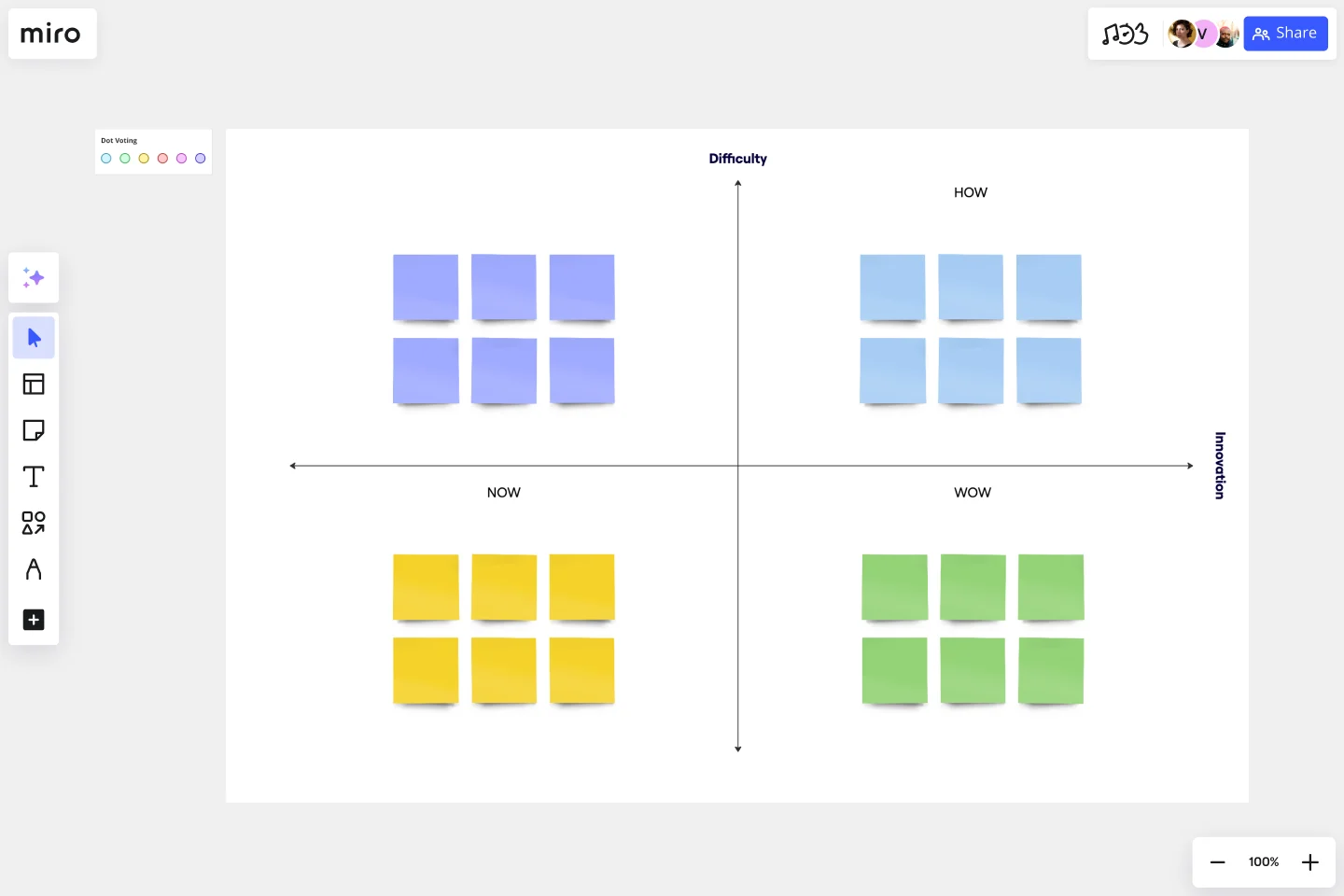How Now Wow Matrix Template
Brainstorm and organize ideas based on their originality and ease of implementation.
About the How Now Wow matrix template
What is How Now Wow?
Brainstorming is difficult — but it becomes increasingly difficult as you scale. As you release more and more innovative products and services, it’s harder for your team to get creative. Complicated workflows, hard judgment calls, and resource constraints often force you to be conservative when you’d rather take risks. To overcome this challenge and reinvigorate your team, you can use the How Now Wow matrix.
The How Now Wow matrix is a game that fosters creativity. It consists of a 2x2 matrix with “originality” on the X-axis and “feasibility” on the Y-axis. You work with your team to file your ideas into each category. Working through the matrix can empower you to overcome creative roadblocks.
How do you use the How Now Wow matrix?
The horizontal axis represents originality and rates ideas as normal or innovative. The vertical axis represents ease of implementation and rates ideas as easy or difficult to implement. Ideas that are unoriginal and challenging probably aren’t worth pursuing. “How” ideas that are innovative but difficult to execute may need further work before you can act upon them. “Now” ideas are generally considered low-hanging fruit. “Wow” ideas are both innovative and relatively easy to implement, so this is where you’ll want to try to focus your attention.
The 3 Aspects of How Now Wow
How: Difficult to implement.
This category consists of ideas that are innovative but infeasible. It’s a helpful way to set ambitious goals for the future.
Now: Easy to implement.
These ideas are familiar, so you know they work well.
Wow: Original and easy to implement.
This category describes creative ideas that are relatively simple to execute. Try to file as many ideas into this category as possible.
Who can use the How Now Wow matrix?
The How Now Wow matrix is versatile enough to be used by any number of teams. Use it whenever you’d like to encourage your team to do creative brainstorming. In order to encourage maximum creativity, you may find it beneficial to break teams into smaller groups or let people brainstorm individually before sharing their ideas with a larger group.
Get started with this template right now.
Opportunity Canvas Template
Works best for:
Leadership, Decision Making, Strategic Planning
Features and capabilities — they make or break a product, which is why companies spend so much time and effort focusing on them. Sound like you? Try it with an Opportunity Canvas. This streamlined one-pager gives you and your team the power to improve your product by exploring the use cases, potential setbacks, strategies, challenges, and metrics. An Opportunity Canvas is ideal if you’ve already built a product, because you don’t need to consider the operational or revenue model.
SCAMPER Model
Works best for:
Ideation, Operations, Brainstorming
Is your team in a rut? Have you had a lingering problem that can’t seem to be solved? First introduced in 1972, SCAMPER. is a brainstorming method developed by Bob Eberle, an author of creativity books for young people. This clever, easy-to-use method helps teams overcome creative roadblocks. SCAMPER walks you through seven questions that are meant to encourage your team to approach a problem through seven unique filters. By asking your team to think through a problem using this framework, you’ll unlock fresh, innovative ways to understand the problem you’re trying to solve.
Mental Model Template
Works best for:
Business Management, Mind Mapping, Diagrams
Smart solutions and strong, strategic decisions. The best organizations make both, and a mental model is designed to help them do it. We give you a fast and easy way to try it out — just fill out our ready-made, flexible template and add sticky notes, shapes, and arrows to create a powerful map.
3x3 Prioritization Method Template
Works best for:
Operations, Prioritization, Strategic Planning
It’s all about assessing a task or idea, and quickly deciding the effort it will take and the potential impact it will have—ranked low, medium, or high. That’s what the 3x3 prioritization method does: Help teams prioritize and identify quick wins, big projects, filler tasks, or time-wasters. With nine bucket areas, it offers slightly greater detail than the 2x2 Prioritization Matrix (or Lean Prioritization Method). It’s easy to make your own 3x3 prioritization matrix—then use it to determine what activities or ideas to focus on with your valuable resources.
Idea Funnel Backlog
Works best for:
Design, Brainstorming, Agile Workflows
An Idea Funnel Backlog enables you to visualize your backlog and restrict the number of backlogged items at the top. In doing sos, you can prioritize items on your list without having to engage in unnecessary meetings or create too much operational overhead. To use the Idea Funnel Backlog, break up the funnel into different phases or treat it like a roadmap. Use the Idea Funnel Backlog as a hybrid model that combines your roadmap and backlog into one easily digestible format.
Reverse Brainstorming Template
Works best for:
Ideation, Brainstorming, Team Meetings
Reverse brainstorming is a technique that prompts a group to think of problems, rather than solutions. Because we naturally think of problems, it’s a great way to get a group to anticipate problems that may occur during a project. To engage in reverse brainstorming, start by identifying the problem, and then think of things that might exacerbate it. Ask your team to generate ideas around ways in which the problem could get worse. Reverse the problems into solutions again, and then evaluate your ideas.
